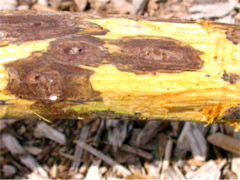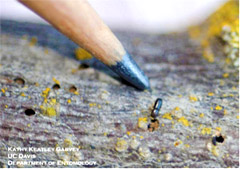Beware of a New Tree Disease

One of the best ways to predict insect and disease problems for your landscape is by noting past issues along with observing current weather conditions. Insects are unable to generate their own body heat, therefore the emergence and life cycle of these creatures is dependant on environmental conditions. Along with insect problems, landscape diseases are also related to the weather. Bacteria, fungi, and viruses all have environmental requirements in order to grow and reproduce.
A new and very serious disease affecting the Black Walnut tree is Thousand Cankers Disease (TCD). In 2009, TCD was responsible for the massive amount of black walnut deaths throughout the western states. The disease is caused by a fungus that attaches to the walnut twig beetle. The beetles themselves cause very little damage, but the fungus they carry creates small areas of dead tissue under the tree’s bark.

Early symptoms of TCD are the yellowing and thinning of the tree’s upper crown. The symptoms then progress to the dieback of larger branches; with the final stages of this disease causing large areas of the foliage to rapidly wilt. This disease can kill a tree 1-3 years after the initial infection. On April 12, the Missouri Department of Agriculture issued a state exterior quarantine to protect the state’s black walnut trees. If you suspect Thousand Cankers disease has infected walnuts on your property, be sure to contact our office immediately. This disease is highly contagious and devastating to neighboring walnut trees.
The History of Arbor Day
Every April, many people wonder to themselves, “Why do we need a holiday just for trees?”. With so many holidays on the calendar, Arbor Day often goes unnoticed. However, this particular holiday is growing more important each year.
The first Arbor Day was observed on April 10, 1872. Julius Sterling Morton, a journalist and politician from Nebraska, was inspired to dedicate a day to trees from his own passion for agriculture. Morton lead by example, planting numerous orchards and shade trees on his farm; and urged his neighbors to do the same. He felt that his home state would benefit both aesthetically and economically by wide scale planting.
Morton’s golden opportunity arrived when he became a member of Nebraska’s State Board of Agriculture. He then proposed that one day of the year be dedicated to raising awareness of the importance of trees and tree planting. His idea was a wild success and more than one million trees were planted that first Arbor Day. In 1885, Nebraska deemed it an annual holiday, to be celebrated on April 22 (Morton’s Birthday) Soon all 50 states followed. In 1970, President Richard Nixon dedicated the last Friday in April as Arbor Day.
Today, Variations of Arbor Day are celebrated all over the world. It is “Greening Week” of Japan, “Tree Loving Week” of Korea, “The Reforestation Week” of Yugoslavia, “- and the list certainly goes on. So, this year we urge you to join us in the celebration of trees. Plant your favorite tree for yourself, a loved one, or a neighbor. Don’t make this Arbor Day, just another day on the calendar!
Buried Alive: The Proper Way to Plant a tree
Homeowners spend hundreds of dollars each year on new trees which eventually die because they were planted too deeply. Proper planting is essential for the failure or success of a young tree.
Don’t waste your money this year – Follow these planting guidelines:
- Measure the height and diameter of the root ball or root spread
- Dig the hole 1-3″ shallower than the root ball or root depth. The hole’s diameter should be 2 to 3 times the diameter of the root ball or root spread.
- Carefully loosen the roots, so that they may spread when planted.
- The tree should be planted so that the root flare, the base of the tree trunk where the roots begin to “flare out” is visible and above ground.
- Backfill with soil from the planting hole, using water to pack or settle the soil around the root ball.
- Mulch the planting area with 2-4″ of an organic mulch such as wood chips. Start the mulch 6″ away from the tree trunk. Do not mulch up or against the trunk.
- Steak and/or protect the trunk of the tree. Make sure to remove the guy wires when the staking is no longer needed or the tree could be injured or even killed from girdling by the wire
If you are interested in planting a new tree this season, feel free to contact K.C. Arborist. Our certified arborists can select a beautiful tree specific to your landscaping needs. See the featured article “Arbor Day Special” for more information.
Water Wise: Watering Your New Tree
Soil temperature and moisture conditions are both important factors when planting a young tree. Be sure to water your tree thoroughly; before planting, at the time of planting, and again the next day after planting, to settle the soil and eliminate large air pockets. Problems begin to emerge when the medium in the root ball retains or accepts moisture differently than the surrounding soil. The backfill soil may be thoroughly saturated, while the medium in the root ball is dry.
Unless there is rainfall, you should water your new tree one- two times per week during the first month after it is planted. After that month, a 10 gallon weekly soaking will be sufficient to support the tree during the spring and summer months. It is easy to over-water in the efforts to get a new tree off to a good start. However, this may keep the soil excessively wet, causing “wet wilt” which looks similar to wilt induced by dryness. Excessive watering also causes root damage from the depletion of oxygen.
Continue regularly watering your new tree as long as it is considered a new transplant. The establishment period for a young tree extends through the first three growing seasons. As the root system of the tree expands, you should water in a wider ring around the base, soaking the soil to a depth of 8-12″.
An organic mulch around the base of the tree is recommended to maintain soil moisture and temperature. It is crucial that the mulch does not touch the base of the tree! Apply the mulch ring 2-3″ deep and at least 1′ away from the trunk. Mulch that comes in contact with the trunk can cause canker infections or decay.









